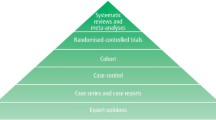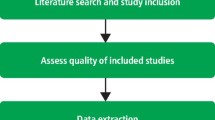Abstract
Data sources
Journal selection was from the 2003 Journal Citation Reports Science Edition (for dental journals) and the 2005 Journal Citation Reports Science and Social Science Edition (for the non-dental journals). The database searched was the Ovid version of Medline.
Study selection
Studies had to be in English, with a predominantly qualitative approach, published between 1999 and 2004 (for dental journals) and between 2002 and 2006 (for non-dental journals)
Data extraction and synthesis
Articles were screened by a research team experienced in sociology, psychology and oral health qualitative research. Two researchers independently appraised each paper and reached consensus, involving a third researcher to resolve disagreements where necessary. The Critical Appraisal Skills Programme (CASP) appraisal framework for qualitative research was used to assess the quality of the papers and this was one of the outcomes. The main outcome was the percentage of the CASP criteria which were fully met for each study, and these were then grouped under journal impact factor range.
Results
Forty-three qualitative research papers were appraised. Twenty-five were in dental journals and 18 in non-dental journals. There was a gradient in the number of studies published according to the journal impact factor, with the highest impact factor journals publishing the least qualitative research. There was a general lack of detail in reporting within the papers, with 35% of the studies providing little or no details about the analysis process, such as the stages involved or derivation of themes. Methodological rigour was considered deficient in many of the studies and in a number of areas: eg data saturation was mentioned in only 25% of studies; how contradictory data were managed was discussed in 25%; and a third of the studies gave little justification for the methods chosen.
Conclusions
The quality of much of the published qualitative dental research is mediocre when assessed using the CASP framework, and several specific areas have been identified for targeting improvement, including better methodological rigour and increased detail in reporting.
Similar content being viewed by others
Commentary
Research in dentistry has mainly focused on quantitative approaches. However, the relevance of qualitative research to oral health research, with its ability to answer certain types of questions and explain behaviour, examine preferences, attitudes and feelings etc, is gaining wider understanding and acceptance. This well carried out and detailed systematic review presents a clear (if slightly outdated now) picture of the landscape of qualitative research within dentistry.
The research was carried out as two separate MSc research projects, which perhaps explains why the search periods end four and six years ago. The first phase was an assessment of the quality of qualitative studies published in dental journals (1999 to 2004) and the second phase covered dental topics in non-dental journals (2002 and 2006). Compiling the findings over slightly different, albeit overlapping timescales is a slight shortcoming although not likely to result in much difference in reporting quality.
The authors make the valid point that there is no universally accepted standard reporting and quality appraisal tool for qualitative research. They adequately justify their use of the Critical Skills Appraisal Programme framework ‘as a series of guiding principles’.
There were very few qualitative studies published in the higher impact journals and the researchers suggest that this might reflect the relatively unrecognised importance of qualitative research in the oral health field. However, they do also acknowledge that it could be because submitted research was not of a high enough standard to be published in these journals, given that the quality of the studies was found to be ‘mediocre’ overall.
This review is a useful snapshot of the quality of published qualitative dental research. With the emerging and developing nature of the field of qualitative research it will be interesting to compare these findings with those of more recent papers by repeating this exercise for literature from 2006/8 onwards. As qualitative research methodologies become more commonly used and reported, an increase in their quality is likely to be seen.
Author information
Authors and Affiliations
Additional information
Address for correspondence: Mohd Masood, Department of Community Dentistry, Faculty of Dentistry, Universiti Teknologi MARA, Shah Alam, 40450, Malaysia. E-mail: mohdmasood@hotmail.co.uk
Masood M, Thaliath ET, Bower EJ, Newton JT. An appraisal of the quality of published qualitative dental research. Community Dent Oral Epidemiol 2011; 39: 193–203.
Rights and permissions
About this article
Cite this article
Innes, N. Quality of the published qualitative dental research is mediocre. Evid Based Dent 13, 122 (2012). https://doi.org/10.1038/sj.ebd.6400903
Published:
Issue Date:
DOI: https://doi.org/10.1038/sj.ebd.6400903



